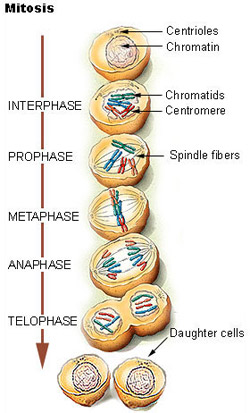Cell Function
The structural and functional characteristics of different types of cells are determined by the nature of the proteins present. Cells of various types have different functions because cell structure and function are closely related. It is apparent that a cell that is very thin is not well suited for a protective function. Bone cells do not have an appropriate structure for nerve impulse conduction. Just as there are many cell types, there are varied cell functions. The generalized cell functions include movement of substances across the cell membrane, cell division to make new cells, and protein synthesis.
Movement of substances across the cell membrane
The survival of the cell depends on maintaining the difference between extracellular and intracellular material. Mechanisms of movement across the cell membrane include simple diffusion, osmosis, filtration, active transport, endocytosis, and exocytosis.
Simple diffusion is the movement of particles (solutes) from a region of higher solute concentration to a region of lower solute concentration. Osmosis is the diffusion of solvent or water molecules through a selectively permeable membrane. Filtration utilizes pressure to push substances through a membrane. Active transport moves substances against a concentration gradient from a region of lower concentration to a region of higher concentration. It requires a carrier molecule and uses energy. Endocytosis refers to the formation of vesicles to transfer particles and droplets from outside to inside the cell. Secretory vesicles are moved from the inside to the outside of the cell by exocytosis.
Cell division

Cell division is the process by which new cells are formed for growth, repair, and replacement in the body. This process includes division of the nuclear material and division of the cytoplasm. All cells in the body (somatic cells), except those that give rise to the eggs and sperm (gametes), reproduce by mitosis. Egg and sperm cells are produced by a special type of nuclear division called meiosis in which the number of chromosomes is halved. Division of the cytoplasm is called cytokinesis.
Somatic cells reproduce by mitosis, which results in two cells identical to the one parent cell. Interphase is the period between successive cell divisions. It is the longest part of the cell cycle. The successive stages of mitosis are prophase, metaphase, anaphase, and telophase. Cytokinesis, division of the cytoplasm, occurs during telophase.
Meiosis is a special type of cell division that occurs in the production of the gametes, or eggs and sperm. These cells have only 23 chromosomes, one-half the number found in somatic cells, so that when fertilization takes place the resulting cell will again have 46 chromosomes, 23 from the egg and 23 from the sperm.
DNA replication and protein synthesis
Proteins that are synthesized in the cytoplasm function as structural materials, enzymes that regulate chemical reactions, hormones, and other vital substances. DNA in the nucleus directs protein synthesis in the cytoplasm. A gene is the portion of a DNA molecule that controls the synthesis of one specific protein molecule. Messenger RNA carries the genetic information from the DNA in the nucleus to the sites of protein synthesis in the cytoplasm.
